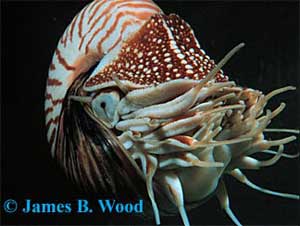At the bottom of the deep sea, several hundred meters down in tropical and subtropical regions, there exists an ancient and primitive creature known as the nautilus. It can freely regulate the distribution of gas within its gas chambers to control its buoyancy and can expel water through its funnel to navigate through the blue waters, resembling the operation of a submarine. This fascinating creature is often referred to as the living submarine.
 |
(Image: nhm.ac.uk) |
The nautilus is a very ancient mollusk that has endured a tumultuous life for 350 million years. Today, only four species remain, classifying them as living fossils.
The nautilus possesses a beautifully hard shell, adorned with alternating gray and red wavy patterns on the outside and a shiny white-silver nacre lining on the inside, resembling exquisite jewelry. The soft body of the nautilus sits within the shell and is symmetrically arranged on both sides. From the center of the shell to the mouth, there are membranes that divide the shell into more than 30 gas chambers, with the body occupying only the outermost chamber, while the others remain vacant. Between these chambers, there are siphons that regulate the gas distribution, allowing the nautilus to rise or sink.
The nautilus is the oldest surviving cephalopod species. Around its mouth and on both sides of its head, it has 90 tentacles, with two particularly thick ones that it can retract into the shell to seal the opening for protection. When hunting for prey, all of its tentacles extend outward, but when resting, they retract into the shell, leaving only a few extended for vigilance. It also features a water jet funnel made up of two muscular pieces.
Typically, the nautilus lies concealed at the bottom of the deep sea, moving by means of its tentacles, ambushing prey among coral and rock formations; occasionally, it will use its funnel to propel itself. Especially after storms in the afternoon, they can be seen rising to the water’s surface in groups, but only for a short time before returning to the depths.

Cross-section of a nautilus shell (Image: pbase)




















































